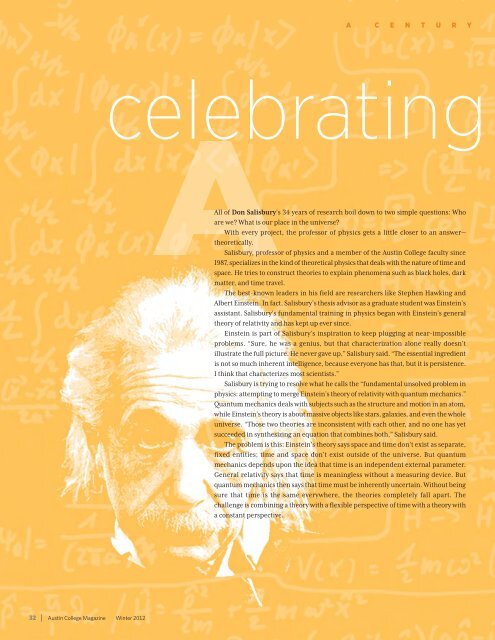Winter 2012 - Austin College Magazine
Winter 2012 - Austin College Magazine
Winter 2012 - Austin College Magazine
You also want an ePaper? Increase the reach of your titles
YUMPU automatically turns print PDFs into web optimized ePapers that Google loves.
A C E N T U R Y<br />
celebrating<br />
All of Don Salisbury’s 34 years of research boil down to two simple questions: Who<br />
are we? What is our place in the universe?<br />
With every project, the professor of physics gets a little closer to an answer—<br />
theoretically.<br />
Salisbury, professor of physics and a member of the <strong>Austin</strong> <strong>College</strong> faculty since<br />
1987, specializes in the kind of theoretical physics that deals with the nature of time and<br />
space. He tries to construct theories to explain phenomena such as black holes, dark<br />
matter, and time travel.<br />
The best-known leaders in his field are researchers like Stephen Hawking and<br />
Albert Einstein. In fact, Salisbury’s thesis advisor as a graduate student was Einstein’s<br />
assistant. Salisbury’s fundamental training in physics began with Einstein’s general<br />
theory of relativity and has kept up ever since.<br />
Einstein is part of Salisbury’s inspiration to keep plugging at near-impossible<br />
problems. “Sure, he was a genius, but that characterization alone really doesn’t<br />
illustrate the full picture. He never gave up,” Salisbury said. “The essential ingredient<br />
is not so much inherent intelligence, because everyone has that, but it is persistence.<br />
I think that characterizes most scientists.”<br />
Salisbury is trying to resolve what he calls the “fundamental unsolved problem in<br />
physics: attempting to merge Einstein’s theory of relativity with quantum mechanics.”<br />
Quantum mechanics deals with subjects such as the structure and motion in an atom,<br />
while Einstein’s theory is about massive objects like stars, galaxies, and even the whole<br />
universe. “Those two theories are inconsistent with each other, and no one has yet<br />
succeeded in synthesizing an equation that combines both,” Salisbury said.<br />
The problem is this: Einstein’s theory says space and time don’t exist as separate,<br />
fixed entities; time and space don’t exist outside of the universe. But quantum<br />
mechanics depends upon the idea that time is an independent external parameter.<br />
General relativity says that time is meaningless without a measuring device. But<br />
quantum mechanics then says that time must be inherently uncertain. Without being<br />
sure that time is the same everywhere, the theories completely fall apart. The<br />
challenge is combining a theory with a flexible perspective of time with a theory with<br />
a constant perspective.<br />
32 | <strong>Austin</strong> <strong>College</strong> <strong>Magazine</strong> <strong>Winter</strong> <strong>2012</strong>





